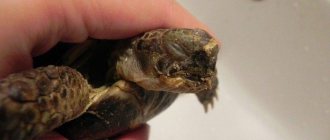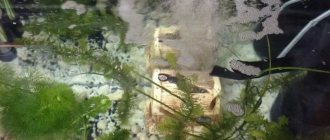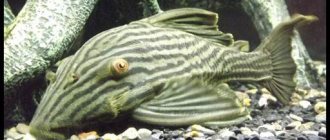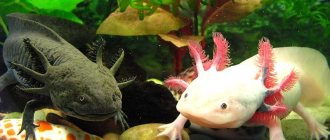The axolotl is an amazing and rare representative of living amphibian creatures with the unusual appearance of a miniature dragon. It is called an aquatic or aquarium dragon, a water salamander and even a monster. The unique appearance inspired animators to create images of cartoon characters. In the wild, the axolotl is considered an endangered species, but it is actively bred in captivity. But those who want to get an unusual pet will have to create ideal living conditions for it.
Benthosaurus
The strange deep-sea fish, which moves on stilt-like, highly elongated fins, was first noticed by French researchers in 1957.
The creature walks along the bottom, is capable of jumping, and strangely raises its head when moving. Scientists believe that this is how it cleans its gills or determines the position of other inhabitants of nearby territories, focusing on their smell.
The body of the fish is small - from ten to thirty centimeters. This fish with legs stands out from others not only in its manner of movement. Benthosaurs are hermaphrodites. Scientists have not yet determined how exactly fertilization occurs in them - whether a second individual is needed for the exchange of sex cells or reproduction occurs through self-fertilization of bisexual fish.
Benthosaurs are found at depths of up to six thousand meters. Perhaps more, but so far this fact has not been recorded. Despite its amazing properties, this fish with legs cannot be called too rare - in the area of the Hawaiian Islands, on average, one individual is found for every hectare.
Toothed greenlings in cooking
Despite their scary appearance, toothy greenlings are a valuable game fish. In terms of quality, their meat is not inferior to salmon and halibut. Young fish have greenish flesh, while adult fish have white flesh. The liver of these fish contains a lot of vitamins A and D, and the meat is rich in insulin. Greenlings are rarely caught on regular fishing rods, so fishermen use bottom nets during commercial fishing. In 1991, a record number of toothy greenlings were caught - more than 9 thousand individuals.
The meat of some greenlings is blue
Frog fish
The generalized known name for fish with legs is the definition of "frog". These include quite a few species belonging to the clown family (Antennariidae) and members of the order Anglerfishes. They are classified as a species of monkfish.
Among them there are gigantic and psychedelic ones, having flabby skin without scales, characteristic of the species, but striking with a combination of colors and abstract lines. There are flashy, decorated and hairy ones. Representatives of frog fish can come in a wide variety of sizes, colors and shades.
These fish have learned, like some that move along the bottom, to use their lower fins to save energy. In many deep-sea fish that live closer to the bottom, the swim bladder even disappeared during the process of evolution.
The fins of frog fish resemble paws - they use them accordingly. Often these limbs are compared to arms or legs.
Range, habitats
In nature, the axolotl has become a very rare species. They are considered endemic because they live almost exclusively in two mountain lakes in Mexico - Cholco and Xochimailco, located in Mexico City, at an altitude of more than 2 thousand m above sea level. There, the Aztecs once built the so-called floating islands “chinampas”, and today various ornamental plants are grown on them. Perfectly irrigated, these islands and the channels between them are very convenient for axolotls and adult ambistos to live in, so they actively reproduce there.
Since the mid-19th century, domestic hobbyists and collectors have been actively breeding cute amphibians. It is not difficult to keep them in captivity, they reproduce well, are unpretentious to conditions and food, do not cause concern with their behavior, and therefore are very popular as pets.
This is interesting!
Experiments on tissue regeneration were carried out on axolotls, so quite a large number of them were raised as laboratory animals.
Criteria for choosing an aquarium
The size of the aquarium depends on how many fish you intend to keep
. Ideally, it is better to have separate containers for each axolotl, because adult salamanders interfere with each other, especially if they are of different ages. A “seasoned” male can offend a young axolotl, injure it, or even eat it.
Important!
Individuals of different sizes cannot be kept together. Only axolotls of approximately the same age and parameters can live together; they should have space.
Two young individuals together can be kept in a 50 liter container, but when they grow up, this space should be given to each of them, and it is better to keep no more than a couple of larvae in a spacious aquarium of about 80-100 liters.
Aquarium equipment
“Triton” cannot simply be thrown into the water. It is necessary to provide an environment in the aquarium that is similar to the natural one. An axolotl will not be able to live without soil, a large number of shelters, or in bright light. So, what does a caring owner need to take care of?
Priming
Mandatory, as salamanders move their paws and cling to it. Without soil, they experience constant stress, and their paws can even become covered with ulcers. Small pebbles and gravel, as well as sand, are not the best choice; axolotls can swallow them, which can create problems for their gastrointestinal tract. Take a pebble that won't fit in the axolotl's mouth.
Shelters
They will not only create a comfortable environment for your pet, but will also give the aquarium a decorative look. The number of “houses” should be greater than both in the aquarium, each larva should have a choice. Make sure that objects in the aquarium do not have sharp edges or broken edges, because the skin of “Mexicans” is very delicate. You can place in the aquarium:
- driftwood;
- ceramic houses and figurines;
- stones of different sizes;
- arches;
- pots;
- halved coconuts, etc.
Axolotl
Very often, when asked what a fish with legs is called, a fashionable animal comes to mind - the Mexican water dragon. He is not a fish. According to the zoological classification, the axolotl belongs to amphibians, although the appearance of the creature is not typical for them. However, it is often mistakenly referred to colloquially as an unusual fish with legs.
The axolotl justifies the title of fish, perhaps, only by its way of life - it does not go onto land. External gills allow the animal to extract the oxygen necessary for breathing from the fresh, cool water of deep-sea lakes, in which it prefers to live.
Axolotls can live for ten years, and the maximum size of representatives of the species is just under half a meter. The average individual grows to 20-30 centimeters.
Features of caring for an axolotl, keeping it at home
The nutrition of the axolotl and its maintenance at home worries many novice aquarists. But breeding and caring for the Mexican axolotl is only possible for experienced breeders due to increased requirements.
Varieties of axolotls for home keeping
The most common species suitable for aquarium keeping are:
- Mexican natural grass of black or grayish-brown hue;
- white with milky white skin and dark stripes;
- albino white and golden in color with red eyes;
- Harlequin is light in color with dark spots.
Requirements for the size and arrangement of the aquarium
The axolotl is very responsive to its conditions. An adult requires an aquarium with a volume of at least 100 liters; cubs of 3-4 months feel comfortable in a forty-liter container.
Other habitat requirements:
- The water dragon loves to crawl along the bottom. Small and sharp stones that can leave wounds on the limbs are not suitable as soil. It is preferable to use sand or pebbles with a fraction of 4-6 mm.
- It is necessary to arrange shelters: holes, grottoes, pots. Decor of a smooth, streamlined shape is also required.
- For natural shading of the aquarium and reproduction of larvae, plants will be required: hornwort, cladophora, riccia, echinodorus, cryptocorynes, pistia, anubias.
Keeping an axolotl in an aquarium is not an easy task. In addition to arranging a “home,” the amphibian requires compliance with other important rules.
Temperature, light
The liquid in the aquarium should be cool, ranging from 19 to 21°C, which presents certain difficulties. Elevated temperatures cause a lack of oxygen and have a detrimental effect on the amphibian.
The visual organs of water dragons are not very developed. They require moderate lighting. The length of daylight varies depending on the breeding season.
Filtration and aeration
Filtration and aeration should be appropriate to the volume of the aquarium and not create too strong a current. It is necessary to choose a compressor with increased ability to aerate water.
Water parameters
The axolotl lives only in clean, cool water and is sensitive to the slightest pollution. As for other parameters, it is also important to follow the rules:
- water temperature no more than 6-16°C;
- pH level – from 7.0 to 8.0 pH.
Sharing with fish
The axolotl fish is a predator. Not all aquarium inhabitants can get along with it. The axolotl, which feeds on protein foods, has low compatibility with small fish. It will attack not only adults, but also feed on their eggs.
If you plan to live together with aquarium fish and an axolotl, it is important to know what fish you can keep it with. A water dragon's neighbors must meet the following requirements:
- feel comfortable in cool water;
- swim fast;
- match the size of the axolotl fish or be slightly smaller, so as not to attack and be eaten.
Pineapple fish
It does not have legs, but it uses its fins to get out of the water and can spend up to eight hours on land.
Not only does it move using its lower fins, but it is also capable of climbing onto stones, bushes and even trees.
The habitat of these fish is the southern part of Asia. Individuals grow up to approximately 35 centimeters. The colors match the vegetation and soil - from brown to green.
Fish with legs is a rather colloquial phenomenon, since these inhabitants of the waters have no limbs in principle. However, walking, crawling and climbing fish, using various parts of their body for this, is a completely ordinary thing, despite all its atypicality for the species in general.
LiveInternetLiveInternet
Eternal childhood
He can grow new paws and a tail if he suddenly loses them. He can reproduce while remaining a child. He may never grow up at all - and will live longer. The axolotl has plenty of reasons to smile - he has adapted well
ZOOSPRAVKA
Mexican axolotl Ambystoma mexicanum
Kingdom - animals Type - chordates
Class - amphibians Order - tailed amphibians
Family - Ambystomaceae Genus - Ambystomaceae
Species: Mexican Ambystoma
It all started with the Aztecs. One of the UNESCO World Heritage Sites in Mexico is Xochimilco. Ancient Aztec canals emerge from the local lake. Boats with tourists glide along their surface, and in the depths of the waters lives the ancient and eternally youthful endemic of the lake - the Mexican axolotl. Initially, these animals lived in two lakes, Chalco and Xochimilco, and were revered by the Aztecs as a deity: according to one version, the axolotl was named after the Aztec god of death and destruction, according to another, its name is translated as “water toy.” Their divine status, however, did not prevent the aborigines from hunting them and using them for food. But this was not a big problem for axolotls - they reproduce very quickly. Much faster than the Aztecs. Difficulties for the species began already in our time: Lake Xochimilco, the last refuge of wild Mexican axolotls, is gradually becoming shallow - the growing Mexico City requires more and more water. Now they have been given the status of an endangered species, despite the fact that millions of Mexican axolotls are thriving and breeding in aquariums around the world.
Aquarium axolotls have an amazing variety of colors.
Adult children
The axolotl is not a separate species of animal, but the larva of a tailed ambystoma amphibian. But unlike, for example, a tadpole (frog larva), an axolotl may not transform into an adult form. It can even reproduce while remaining a larva. This amazing ability is called neoteny (from the ancient Greek νέος - “young” and τείνειν - “stretch”). In neoteny, only the animal's reproductive system reaches the adult level of development, while the remaining organs remain in the larval state.
Axolotl eggs a day after hatching
The axolotl has a large head with a mouth that seems to be constantly smiling, translucent soft skin covering a tightly built body, a ridge on the back that turns into a tail swimming membrane, weak thin legs and - the main decoration - luxurious external gills in the form of three feathered branches on the sides of the head. These creatures also breathe through the skin, and older axolotls necessarily have simple lungs that can absorb oxygen from the air (for ambistomas, the lungs become the main respiratory organ).
Eggs at a late stage: young axolotls are about to hatch from them
The axolotl looks touching, as befits a baby. And its adult form, Ambystoma, looks like a salamander. The method of reproduction in adults and children is the same: the male lays compact spermatophores, and the female draws them into herself with the cloaca. A day after internal fertilization, she lays large, pea-sized, jelly eggs on underwater plants, from which larvae hatch in 20–30 days. A newborn axolotl is equipped with feathery external gills; after a week, its hind legs will grow, and after three months, its front legs. The transformation of the axolotl may end here, and then it will not become an ambistoma, or it may not end, depending on your luck. By the way, axolotls and ambistos were once described as different species and even different families. But in 1867, several axolotls were brought from a cold mountain lake in Mexico and released into a warm pond overgrown with water lilies in the Paris Botanical Garden. Part of the first generation of their offspring considered such conditions unacceptable, turned into ambists and crawled onto land to the indescribable amazement of French zoologists. The taxonomy of tailed amphibians had to be urgently revised.
A few months after birth
Transitional age
Why don't axolotls grow up? Because it is not profitable for them, says the most popular hypothesis. Frogs and salamanders are forced to go to land, as the shallow bodies of water in which they lay their eggs become shallow and dry up. Axolotls live in mountain lakes with very stable conditions: clean cold water, a constant food supply and a minimum of threats. What's the point of exchanging this prosperity for land full of dangers? Therefore, the very first random mutation, which allowed ambystoms not to undergo metamorphosis and reproduce in water, was supported by natural selection and fixed in the gene pool. And their pituitary gland began to produce too little thyroid-stimulating hormone to stimulate the thyroid gland to produce the hormone thyroxine, which should trigger metamorphosis, but now does not trigger it without a special invitation.
The vast majority of terrestrial axolotls live in aquariums around the world; there are almost none of them left in nature
In addition, metamorphosis is a very energy-intensive undertaking. In water, an axolotl can live up to 20 years, but after transformation (especially artificially stimulated) into an ambistoma, it lives significantly less. Restructuring organs and changing life support systems is an expensive proposition, and nature, as we know, always tries to cut costs.
Relatives Blind dragons American and European proteas are neotenic larvae of tailed amphibians that have lost the ability to metamorphose and switched to an aquatic lifestyle. And European proteas, which live exclusively in the eternal darkness of underground rivers and cave reservoirs of the Dinaric Highlands, have also lost their sight. But they react to light with the entire surface of their skin, hunt using electromagnetic sensors, have seismic-sensitive cells like the lateral line of fish, can fast for 10 years, and their life expectancy reaches 70 years - an incredible period for a 30-centimeter animal. In the harsh Middle Ages, proteas brought to the surface during a flood were considered to be baby dragons and were killed just in case. Now the European Proteus is under strict protection.
According to another hypothesis, axolotls remain children not because of a good life, but because of iodine deficiency in the mountain reservoirs of their range. Low iodine - low activity of the thyroid gland and lack of thyroxine. But if you raise the level of hormones by adding them to water or food, then the axolotl willy-nilly will have to say goodbye to childhood. In nature, the process of transition to the adult form starts only if conditions change for the worse. In captivity, many individuals have completely lost the ability to metamorphose, and even in poor conditions they would rather die than “grow up.” This is especially true for laboratory animal lines - after all, it is the larval stage that is of greatest interest for research. And breeding axolotls is much easier than trying to get offspring from adult axolotls. So individuals that have confirmed in practice their ability to metamorphose have little chance of passing it on to the next generation, and artificial selection reinforces permanent neoteny in axolotls. It is possible that in the future, Mexican axolotls living in captivity (and there will be no others left) will be completely stuck in childhood.
Features of Life in Captivity
Axolotls are sedentary but voracious predators: they eat fish, small amphibians, insects, crustaceans, and earthworms. In captivity, they are fed strips of raw meat, chicken and offal, being careful not to overfeed, but not leaving them hungry, so that they do not bite off each other’s limbs. The water temperature should not be higher than 22 degrees. Axolotls avoid light and love dark corners. They get used to people quickly, eat from their hands, and can let themselves be petted. They live in captivity up to 20 years.
Organs on stream
Perhaps the Mexican axolotl is the most laboratory animal: the vast majority of its population lives in scientific laboratories. Why did scientists love them so much? There are many reasons. For their unpretentiousness: keeping axolotls is easier than most aquarium fish. For fertility: neoteny allows them to become sexually mature at ten months and produce up to five thousand eggs three times a year: an invaluable quality for genetic research. For large eggs: ideal material for experiments in embryo transfer and nuclear transfer. It is convenient to study primary induction, processes of tissue specialization, development of sensory organs, etc. in axolotl embryos. And of course, biologists around the world adore the axolotl for its main secret - its incredible ability to regenerate. If an axolotl, with someone's help, loses a tail, paw or gill, then in a couple of months it will grow a new organ, no worse than the old one. This is a unique ability for vertebrate reparative regeneration. The answer to the question of how the axolotl does this may mark a new milestone in medicine. But so far we only have intermediate results.
An image of an axolotl on the wall of the Biological Institute (National Autonomous University of Mexico City). Mexican biologists are seriously concerned about the decline in the number of axolotl in its natural habitat
For example, the discovery of the unexpectedly important role of macrophage cells. Their function is traditionally reduced to devouring dead and foreign cells, bacteria and other unwanted agents. It turned out that axolotl macrophages arrive at the wound faster than mammalian macrophages. If its macrophages are blocked, then instead of a new limb, the axolotl will form a stump of scar tissue, just like ours. Scientists do not rule out that it is the molecules secreted by macrophages that are the key to organ regeneration.
Scene
Habitat area of the Mexican axolotl (Ambystoma mexicanum) And perhaps the secret of axolotl regeneration is in its neoteny. In adults with ambistoms, what is cut off is no longer restored. And in axolotls, at the site of amputation, cells similar to the cells of the limb growth zones in mammalian embryos appear. We humans also “know how” to restore lost organs, but only, alas, before birth. And we are very interested in how the axolotl managed to retain this ability even after. It is quite possible that we will be able to apply it in practice. After all, man is also a rather neotenic creature. Throughout our lives, we retain many of the traits and mental activity characteristic of our primate ancestors only in childhood. Our desire for discovery, playfulness and curiosity are, from a biological point of view, true puppyhood. “They were not human beings, but in no other animal have I found such a deep connection with myself,” wrote Argentine Julio Cortazar in his 1952 story “Axolotl.” Perhaps it is not without reason that we see our reflection in their impassive smiling face. https://q99.it/nzR4w6p











